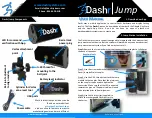
Feniks FUTURE Instruction Manual, No.
033-02-200
edition
IA
, 2012, page
22
of
36
AIR-POL Sp. z o.o.
– 05-120 Legionowo, ul. Olszankowa 52, www.air-pol.com.pl
tel.: (+4822) 774 0711, (+4822) 784 1595, (+4822) 774 4832, fax (+4822) 784 9640, @: [email protected]
3.
CONNECTING MAIN PARACHUTE RISERS TO THE HARNESS/CONTAINER. THE THREE-RING
SYSTEM.
3.1.
THREE-RING RELEASE SYSTEM ASSEMBLY
The release system serves the purpose of cutting away the main canopy in case it does not inflate properly (in case it
malfunctions). Each Feniks harness/container system is fitted with an “Anti-Twist” system preventing a difficult or impossible
pull-out of the cutaway handle in a suspension line twist situation.
The release system consists of the following components, all of which have to be checked prior to assembly (whether they
are operational and clean):
Photo No. 45
•
Harness ring – largest (1)
•
Terminal riser ring – medium (2)
•
Closing loop ring – smallest (3)
•
Closing loop (4)
•
Riser ring (5)
•
Protective casing of the yellow blocking cable
(6)
•
Protective casing eye (7)
•
Yellow blocking cable (8)
•
Main parachute riser (9)
•
RSL system tape connector ring (10)
•
RSL system tape carabineer (11)
•
Cutaway handle (12)
•
Protective casing of the loose end of the yellow
blocking cable (13)
Photo No. 46
1.
Place yellow cables (8) in protective casings,
the ends of which are placed between chest
strap layers.
2.
Place the cutaway handle (12) in the pouch
between the right-hand side vertical main
straps of the harness. The handle shall be
attached to the straps firmly and deeply with
the use of Velcro tape.
Photo No. 47
3.
Prepare the parachute canopy for connection
to the harness. The canopy’s suspension lines
should be free of entanglement. This is best
done when the container and canopy are
arranged as if for packing: the canopy should
be placed with cell openings (vents) facing
downwards, the harness/container’s flaps
should be facing upwards.
Untwisted risers should be placed in front of
the container – riser rings should be lower,
steering toggles should be higher.
1
2
3
6
8
4
10
9
11
12
5
7
8
13















































